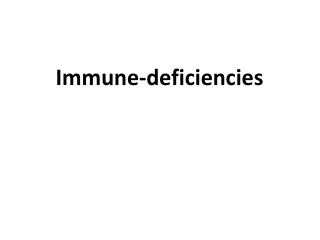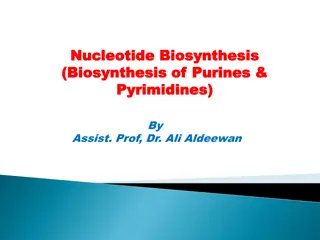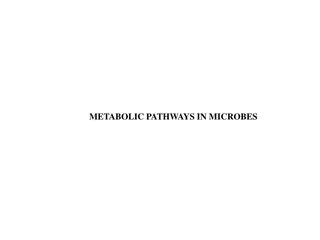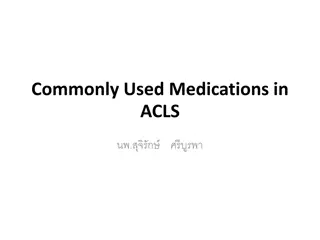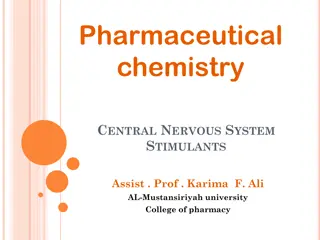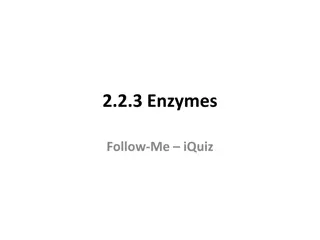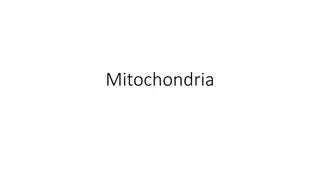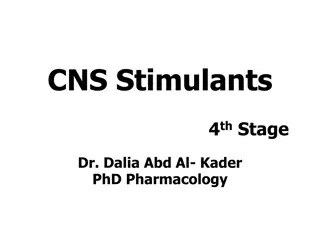Immune-deficiencies
Immune deficiencies can be classified into primary hereditary disorders based on clinical presentations, including cell-mediated, antibody-mediated, non-specific, and complement activation deficiencies. Major clinical manifestations of immune disorders range from B-cell deficiencies to phagocytic ce
2 views • 46 slides
Emergency Drugs and Their Mechanisms of Action
Learn about essential emergency drugs such as Adrenaline, Adenosine, Atropine, Furosemide, Calcium Gluconate, and Lidocaine. Understand their mechanisms of action, dosages, indications, and onset times to effectively manage cardiac arrest, anaphylaxis, arrhythmias, and other critical conditions.
3 views • 17 slides
Understanding Nucleotide Biosynthesis and Nucleic Acids
Exploring the biosynthesis of purines and pyrimidines, essential components for DNA and RNA structures. Delve into the world of pyrimidines, purines, nucleosides, nucleotides, and adenosine derivatives like AMP, ADP, ATP, and cAMP, crucial for various biological processes. Unravel the significance o
5 views • 44 slides
Understanding Metabolic Pathways in Microbes
Metabolism in living organisms involves anabolism and catabolism, where anabolism generates essential biomolecules for growth using energy, while catabolism breaks down nutrients for energy release. Anabolic processes include synthesis of carbohydrates, lipids, proteins, nucleic acids, and other gro
7 views • 24 slides
Commonly Used Medications in ACLS: Adenosine, Amiodarone, Atropine, Dopamine, Epinephrine
Adenosine is used for SVT, Amiodarone for VT/VF, Atropine for bradycardia, Dopamine for shock, and Epinephrine for cardiac arrest. Each medication has specific dosages and side effects. These drugs play crucial roles in advanced cardiac life support scenarios.
8 views • 16 slides
Overview of Central Nervous System Stimulants in Pharmaceutical Chemistry
Central Nervous System Stimulants encompass a diverse group of agents with various effects on the CNS, including analeptics, methylxanthines, central sympathomimetic drugs, and antidepressants. Analeptics are potent CNS stimulants with limited use, while methylxanthines like caffeine have widespread
4 views • 41 slides
Understanding Metabolism: Enzymes and ATP
Explore the concept of metabolism through the roles of enzymes and ATP. Learn about chemical reactions in living cells, substrate interactions, and the essential functions of Adenosine Triphosphate. Test your knowledge with interactive quizzes and uncover the key principles governing cellular proces
0 views • 50 slides
Understanding the Structure and Function of Mitochondria
Mitochondria, derived from Greek words meaning thread and granule, are essential organelles found in eukaryotic cells. They serve as energy powerhouses, metabolizing carbohydrates and fatty acids to produce adenosine triphosphate (ATP). The inner and outer membranes of mitochondria contain proteins
0 views • 14 slides
Mechanism and Clinical Uses of CNS Stimulants
CNS stimulants, including psychomotor stimulants and hallucinogens, have diverse clinical uses but are also potential drugs of abuse. Psychomotor stimulants such as caffeine affect the CNS by translocating extracellular calcium, increasing cyclic adenosine monophosphate, and blocking adenosine recep
0 views • 29 slides
